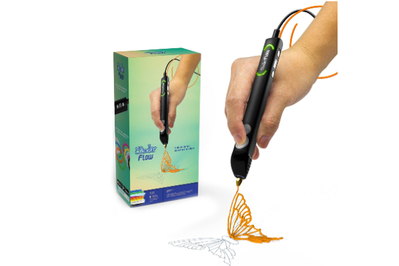The 2 Best 3D Pens of 2025

Top pick
The 3Doodler Flow offers the best overall drawing experience for people ages 12 and older who want to start working with 3D pens. In our testing, it drew clean lines of plastic that solidified quickly, it was the easiest to use, and it was one of the most comfortable pens to hold. It works with multiple tip sizes, too. In addition, 3Doodler’s customer service is by far the most responsive we encountered.
It has a beautifully ergonomic shape that’s comfy to hold. 3D-drawing projects can take a while to complete, but the Flow’s well-designed, soft-textured plastic exterior makes the slightly weighty pen easy to hold for however long your drawing takes.
The design allows the index finger to rest naturally within reach of the pen’s two buttons, which start or stop the flow of filament and control its speed. We found that the pen’s shape was ideal for achieving fine control while drawing. The Flow also stays comfortably cool even during long drawing sessions.
It puts out steady, even strands of plastic as you draw. The lines solidified quickly and stayed put when we drew over them; in contrast, most other pens grabbed onto still-soft filament and dragged it along (much like a low-quality hot-glue gun), warping our drawings.
We appreciate that the Flow gives you the option to either press the button once to extrude — which is great when you’re doing fill work or cruising through easier stencils — or “manually” extrude by holding down the button and stopping the extruding when you lift, which gives you finer control over particularly tricky or intricate sections. The Flow’s fast and slow settings are both comfortable for normal drawing.
Loading and unloading filament is easy. The Flow follows the standard 3D-pen filament-loading procedure, which is similar to that of a glue gun. To unload filament, you double-press the speed button, which runs the filament in reverse until the strand is loose enough to tug out. 3Doodler recommends unloading the pen after every use to prevent long-term damage from storing plastic inside it.

It lets you choose between two heat settings. The settings are designed to accommodate ABS plastic (which melts at about 380 degrees Fahrenheit) or PLA plastic (about 360 degrees), the two options in 3Doodler’s filament lineup (more on this topic below).
It doesn’t clog. When 3D pens first appeared, one of the most common problems was that the filament would clog — the melted plastic would harden and get stuck inside the pen. However, none of the 3Doodler pens we’ve tested, including our former top pick, the Create+, and the company’s kid-friendly models, have clogged on us. The Flow is no exception.
It offers more flexibility with tip sizes. The Flow is one of the very few pens we tested with the option to buy additional tip sizes (you can use them with 3Doodler’s Pro pen, too). One of our experts strongly recommends extra tips, as thin tips give you more control over detail work, and thick tips are better for filling in large areas more quickly.
After testing the various tips, we agree. If you want to have more control over detail work or to speed up infilling, the additional tips will help. 3Doodler also sells two ribbon-like shapes that can be useful for adding texture. You don’t have to buy these tips for a good experience with the Flow, but they certainly help.
One word of caution: Make sure the pen is hot when you swap a tip, or you risk permanently breaking your pen.
3Doodler’s customer service is helpful and responsive. As a part of our first round of testing, we sent each 3D-pen company an email asking if it is safe to use third-party filament. 3Doodler responded within minutes — the fastest of any company we queried — and was one of only a handful of companies that responded at all.
We also had a chance to interact with 3Doodler’s customer service when our original Create pen stopped working after being shipped cross-country twice. As before, customer service responded within minutes by email. Within 25 minutes of the first response, the representative helping us had diagnosed an electrical issue and offered to send a replacement.
All 3Doodler pens are covered by a one-year warranty.
Flaws but not dealbreakers
It’s incompatible with third-party filament. The Flow comes with eight 10-foot-long spools of plastic filament, which is more than you get with most of the pens we tested. However, if you don’t want to void the Flow’s warranty, you’re locked in to using 3Doodler’s plastic. While it’s a bummer that third-party filament is incompatible, the price of 3Doodler’s plastic is now within range of the generic plastics, so this limitation is not as big a downside as it once was.
The filament has a chemical-like odor. As was the case with all of the other pens we tried, with the Flow, ABS filament gave off a chemical-like odor, while PLA filament strands smelled more like maple syrup.
It produces a whiny motor noise while drawing. Although this noise is annoying and not unique to this model, it is not loud enough to bug someone in the next room.
We wish the cord were longer. The Flow has a 5-foot cord, a length that’s fairly standard for a 3D pen, but it will feel short if your table or other work surface is in the middle of a room far from an outlet, as ours was. You should have a lot of slack in the cord so that you don’t feel any tugging from the top of the pen as you work. We recommend using an extension cord if you don’t plan to use the pen directly in front of an outlet.







